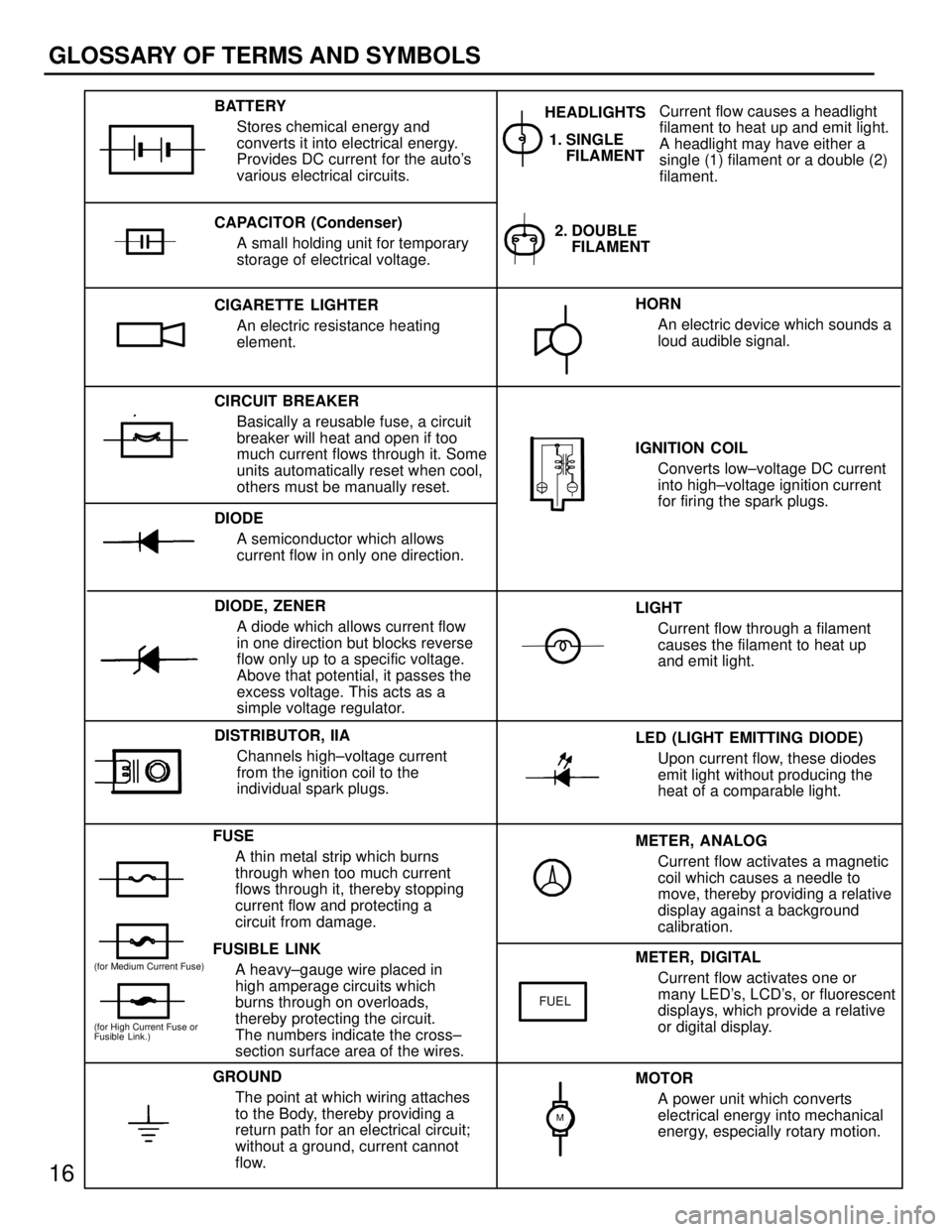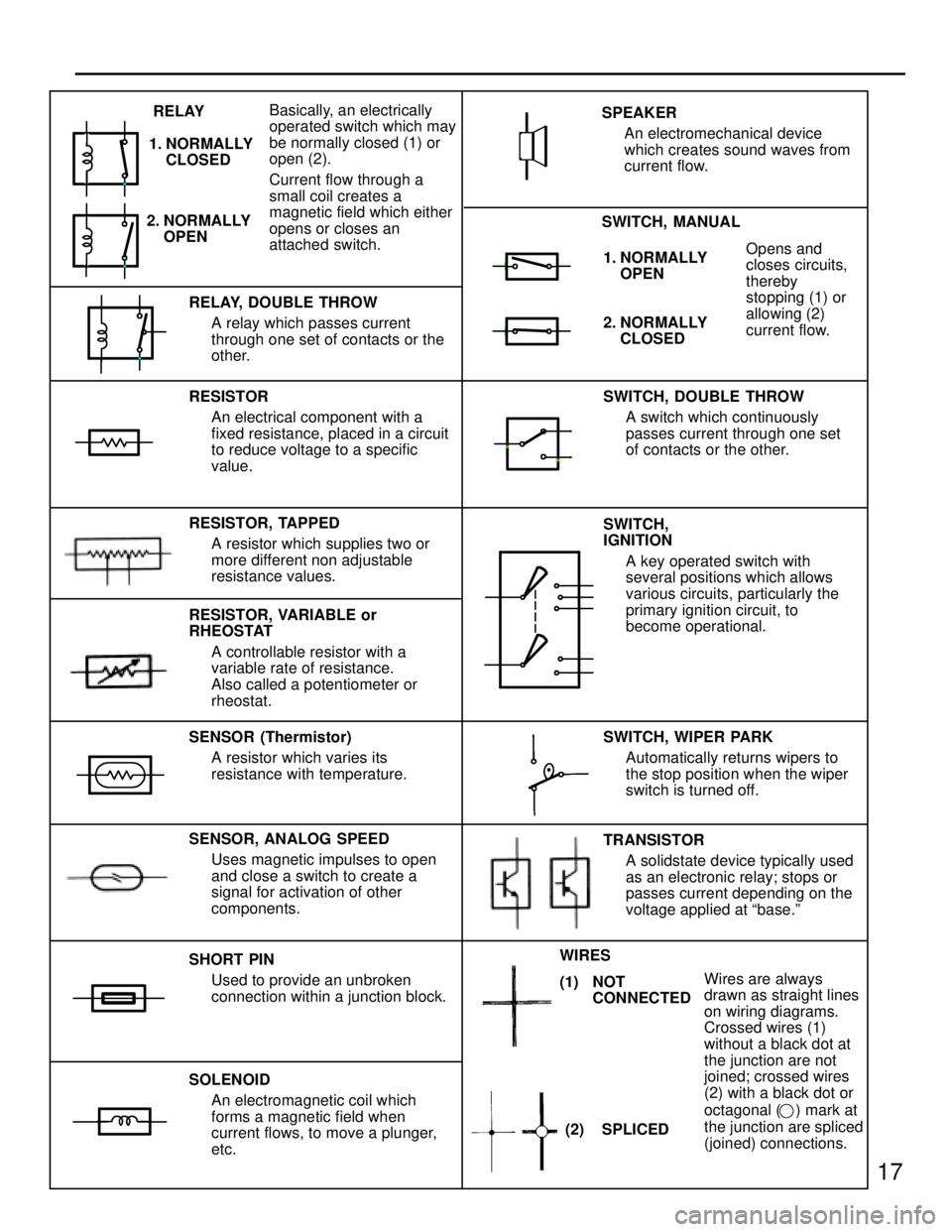1986 TOYOTA SUPRA wiring
[x] Cancel search: wiringPage 604 of 878

3
HOW TO USE THIS MANUAL
This manual provides information on the electrical circuits installed on vehicles by
dividing them into a circuit for each system.
The actual wiring of each system circuit is shown from the point where the power source
is received from the battery as far as each ground point. (All circuit diagrams are shown
with the switches in the OFF position.)
When troubleshooting any problem, first understand the operation of the circuit where
the problem was detected (see System Circuit section), the power source supplying
power to that circuit (see Power Source section), and the ground points (see Ground
Points section). See the System Outline to understand the circuit operation.
When the circuit operation is understood, begin troubleshooting of the problem circuit
to isolate the cause. Use Relay Location and Electrical Wire Routing sections to find
each part, junction block and wiring harness connectors, wiring harness and wiring
harness connectors, splice points, and ground points of each system circuit. Internal
wiring for each junction block is also provided for better understanding of connection
within a junction block.
Wiring related to each system is indicated in each system circuit by arrows (from
, to ). When overall connections are required, see the Overall Wiring Diagram
at the end of this manual.
Page 606 of 878

A
B
C
D
E
F
G
H
I
J
K
L
M
N
O
P
5
:System Title
:Indicates a Relay Block. No shading is used and only
the Relay Block No. is shown to distinguish it from the
J/B.
Example: Indicates Relay Block No. 1.
:Indicates the connector to be connected to a part (the
numeral indicates the pin No.)
Explanation of pin use.
The pins shown are only for the highest grade, or only
include those in the specification.
:Connector Color
Connectors not indicated are milky white in color.
:( ) is used to indicate different wiring and connector,
etc. when the vehicle model, engine type, or
specification is different.
:Indicates related system.
:Indicates the wiring harness and wiring harness
connector. The wiring harness with male terminal is
shown with arrows ( ).
Outside numerals are pin numbers.
The first letter of the code for each wiring harness and
wiring harness connector(s) indicates the component's
location, e.g., ªEº for the Engine Compartment, ªIº for the
Instrument Panel and Surrounding area, and ªBº for the
Body and Surrounding area.
When more than one code has the first and second
letters in common, followed by numbers (e.g., IH1, IH2),
this indicates the same type of wiring harness and
wiring harness connector.
:Represents a part (all parts are shown in sky blue). The
code is the same as the code used in parts position.
:Junction Block (The number in the circle is the J/B No.
and the connector code is shown beside it). Junction
Blocks are shaded to clearly separate them from other
parts (different junction blocks are shaded differently for
further clarification).
3B indicates
that it is inside
Junction Block
No. 3.
Example::Indicates the wiring color.
Wire colors are indicated by an alphabetical code.
B = Black L = Blue R = Red
BR = Brown LG = Light Green V = Violet
G = Green O = Orange W = White
GR = Gray P = Pink Y = Yellow
The first letter indicates the basic wire color and the
second letter indicates the color of the stripe.
Example: L ± Y
(Blue) (Yellow)
:Indicates a wiring Splice Point (Codes are ªEº for the
Engine Room, ªIº for the Instrument Panel, and ªBº for
the Body).
Example:
The Location of Splice Point I 5 is indicated by the
shaded section.
:Page No.
:Indicates a shielded cable.
:Indicates a ground point.
The first letter of the code for each ground point(s)
indicates the component's location, e.g., ªEº for the
Engine Compartment, ªIº for the Instrument Panel and
Surrounding area, and ªBº for the Body and
Surrounding area.
:Indicates the pin number of the connector.
The numbering system is different for female and male
connectors.
Example: Numbered in order
from upper left to
lower rightNumbered in order
from upper right to
lower left
:When 2 parts both use one connector in common, the
parts connector name used in the wire routing section
is shown in square brackets [ ].
Page 608 of 878

Q
R
S
T
U
V
W
X
Junction connector (code: J1, J2, J3, J4, J5,
J6, J7, J8, J9) in this manual include a short
terminal which is connected to a number of
wire harnesses. Always perform inspection
with the short terminal installed. (When
installing the wire harnesses, the harnesses
can be connected to any position within the
short terminal grouping. Accordingly, in other
vehicles, the same position in the short
terminal may be connected to a wire harness
from a different part.)
Wire harness sharing the same short terminal
grouping have the same color.
HINT:
7
:Explains the system outline.
:Indicates values or explains the function for reference during troubleshooting.
:Indicates the reference page showing the position on the vehicle of the parts in the system circuit.
Example: Part ªP4º (Power Window Master SW) is on page 21 of the manual.
* The letter in the code is from the first letter of the part, and the number indicates its order
in parts starting with that letter.
Part is 4th in order
Power Window Master SW Example: P
4
:Indicates the reference page showing the position on the vehicle of Relay Block Connectors in the
system circuit.
Example: Connector ª1º is described on page 16 of this manual and is installed on the left side of the
instrument panel.
:Indicates the reference page showing the position on the vehicle of J/B and Wire Harness in the system
circuit.
Example: Connector ª3Bºconnects the Cowl Wire and J/B No. 3. It is described on page 14 of this
manual, and is installed on the instrument panel left side.
:Indicates the reference page describing the wiring harness and wiring harness connector (the female
wiring harness is shown first, followed by the male wiring harness).
Example: Connector ªID1ºconnects the front door RH wire (female) and cowl wire (male). It is described
on page 26 of this manual, and is installed on the right side kick panel.
:Indicates the reference page showing the position of the ground points on the vehicle.
Example: Ground point ªICº is described on page 24 of this manual and is installed on the cowl left side.
:Indicates the reference page showing the position of the splice points on the vehicle.
Example: Splice point ªI 5º is on the Cowl Wire Harness and is described on page 24 of this manual.
Page 618 of 878

METER, ANALOG
Current flow activates a magnetic
coil which causes a needle to
move, thereby providing a relative
display against a background
calibration. LED (LIGHT EMITTING DIODE)
Upon current flow, these diodes
emit light without producing the
heat of a comparable light. IGNITION COIL
Converts low±voltage DC current
into high±voltage ignition current
for firing the spark plugs. 1. SINGLE
FILAMENT
GROUND
The point at which wiring attaches
to the Body, thereby providing a
return path for an electrical circuit;
without a ground, current cannot
flow.Current flow causes a headlight
filament to heat up and emit light.
A headlight may have either a
single (1) filament or a double (2)
filament. BATTERY
Stores chemical energy and
converts it into electrical energy.
Provides DC current for the auto's
various electrical circuits.
CAPACITOR (Condenser)
A small holding unit for temporary
storage of electrical voltage.
CIRCUIT BREAKER
Basically a reusable fuse, a circuit
breaker will heat and open if too
much current flows through it. Some
units automatically reset when cool,
others must be manually reset.
DIODE
A semiconductor which allows
current flow in only one direction.
DIODE, ZENER
A diode which allows current flow
in one direction but blocks reverse
flow only up to a specific voltage.
Above that potential, it passes the
excess voltage. This acts as a
simple voltage regulator.
FUSE
A thin metal strip which burns
through when too much current
flows through it, thereby stopping
current flow and protecting a
circuit from damage.
FUSIBLE LINK
A heavy±gauge wire placed in
high amperage circuits which
burns through on overloads,
thereby protecting the circuit.
The numbers indicate the cross±
section surface area of the wires.HORN
An electric device which sounds a
loud audible signal.
LIGHT
Current flow through a filament
causes the filament to heat up
and emit light.
METER, DIGITAL
Current flow activates one or
many LED's, LCD's, or fluorescent
displays, which provide a relative
or digital display.
MOTOR
A power unit which converts
electrical energy into mechanical
energy, especially rotary motion. CIGARETTE LIGHTER
An electric resistance heating
element.
DISTRIBUTOR, IIA
Channels high±voltage current
from the ignition coil to the
individual spark plugs.2. DOUBLE
FILAMENT HEADLIGHTS
FUEL
(for High Current Fuse or
Fusible Link.)
(for Medium Current Fuse)
M
16
GLOSSARY OF TERMS AND SYMBOLS
Page 619 of 878

17
1. NORMALLY
OPENOpens and
closes circuits,
thereby
stopping (1) or
allowing (2)
current flow.
RESISTOR
An electrical component with a
fixed resistance, placed in a circuit
to reduce voltage to a specific
value.
RESISTOR, TAPPED
A resistor which supplies two or
more different non adjustable
resistance values.
SENSOR (Thermistor)
A resistor which varies its
resistance with temperature.
SHORT PIN
Used to provide an unbroken
connection within a junction block.
SOLENOID
An electromagnetic coil which
forms a magnetic field when
current flows, to move a plunger,
etc.SWITCH, DOUBLE THROW
A switch which continuously
passes current through one set
of contacts or the other.
SWITCH,
IGNITION
A key operated switch with
several positions which allows
various circuits, particularly the
primary ignition circuit, to
become operational.
Wires are always
drawn as straight lines
on wiring diagrams.
Crossed wires (1)
without a black dot at
the junction are not
joined; crossed wires
(2) with a black dot or
octagonal (
) mark at
the junction are spliced
(joined) connections. RELAY, DOUBLE THROW
A relay which passes current
through one set of contacts or the
other.
SENSOR, ANALOG SPEED
Uses magnetic impulses to open
and close a switch to create a
signal for activation of other
components.TRANSISTOR
A solidstate device typically used
as an electronic relay; stops or
passes current depending on the
voltage applied at ªbase.º SWITCH, WIPER PARK
Automatically returns wipers to
the stop position when the wiper
switch is turned off. SWITCH, MANUAL SPEAKER
An electromechanical device
which creates sound waves from
current flow.
2. NORMALLY
CLOSED
RESISTOR, VARIABLE or
RHEOSTAT
A controllable resistor with a
variable rate of resistance.
Also called a potentiometer or
rheostat. 2. NORMALLY
OPEN RELAY
1. NORMALLY
CLOSEDBasically, an electrically
operated switch which may
be normally closed (1) or
open (2).
Current flow through a
small coil creates a
magnetic field which either
opens or closes an
attached switch.
(2) SPLICED WIRES
(1) NOT
CONNECTED
Page 626 of 878
![TOYOTA SUPRA 1986 Service Repair Manual 24
ELECTRICAL WIRING ROUTING
Position of Parts in Engine Compartment
[2JZ±GTE]
A 1 A/C Ambient Temp. Sensor E 4 Engine Coolant Temp. Sender (Water Temp. Sender)
A 2 A/C Condenser Fan Motor E 5 Engine TOYOTA SUPRA 1986 Service Repair Manual 24
ELECTRICAL WIRING ROUTING
Position of Parts in Engine Compartment
[2JZ±GTE]
A 1 A/C Ambient Temp. Sensor E 4 Engine Coolant Temp. Sender (Water Temp. Sender)
A 2 A/C Condenser Fan Motor E 5 Engine](/manual-img/14/57467/w960_57467-625.png)
24
ELECTRICAL WIRING ROUTING
Position of Parts in Engine Compartment
[2JZ±GTE]
A 1 A/C Ambient Temp. Sensor E 4 Engine Coolant Temp. Sender (Water Temp. Sender)
A 2 A/C Condenser Fan Motor E 5 Engine Coolant Temp. SW (Water Temp. SW)
A 3 A/C Triple Pressure SW E 6 Engine Hood Courtesy SW
(A/C Dual and Single Pressure SW) E 7 Engine Oil Level Sensor
A 4 A/C Magnetic Clutch and Lock Sensor
A 5 A/T Fluid Temp. Sensor F 1 Front Airbag Sensor LH
A 6 ABS Actuator F 2 Front Airbag Sensor RH
A 7 ABS Actuator F 3 Front Fog Light and Parking Light LH
A 10 ABS Speed Sensor Front LH F 4 Front Fog Light and Parking Light RH
A 11 ABS Speed Sensor Front RH F 5 Front Side Marker Light LH
F 6 Front Side Marker Light RH
B 1 Back±Up Light SW (for M/T) F 7 Front Turn Signal Light LH
B 2 Brake Fluid Level Warning SW F 8 Front Turn Signal Light RH
F 9 Front Wiper Motor
C 1 Camshaft Position Sensor No. 1
C 2 Camshaft Position Sensor No. 2 G 1 Generator (Alternator)
C 3 Crankshaft Position Sensor G 2 Generator (Alternator)
C 4 Cruise Control Actuator
H 1 Headlight Hi LH
D 1 Data Link Connector 1 (Check Connector) H 2 Headlight Hi RH
D 2 Daytime Running Light Relay No. 3 H 3 Headlight Lo LH
D 3 Daytime Running Light Relay No. 3 H 4 Headlight Lo RH
H 5 Heated Oxygen Sensor (Main)
E 1 EGR Gas Temp. Sensor H 8 Horn LH
E 2 Electronically Controlled Transmission Solenoid H 9 Horn RH
E 3 Engine Coolant Temp. Sensor (EFI Water Temp. Sensor)
Page 628 of 878
![TOYOTA SUPRA 1986 Service Repair Manual 26
ELECTRICAL WIRING ROUTING
Position of Parts in Engine Compartment
[2JZ±GE]
A 1 A/C Ambient Temp. Sensor E 2 Electronically Controlled Transmission Solenoid
A 3 A/C Dual Pressure SW E 3 Engine Cool TOYOTA SUPRA 1986 Service Repair Manual 26
ELECTRICAL WIRING ROUTING
Position of Parts in Engine Compartment
[2JZ±GE]
A 1 A/C Ambient Temp. Sensor E 2 Electronically Controlled Transmission Solenoid
A 3 A/C Dual Pressure SW E 3 Engine Cool](/manual-img/14/57467/w960_57467-627.png)
26
ELECTRICAL WIRING ROUTING
Position of Parts in Engine Compartment
[2JZ±GE]
A 1 A/C Ambient Temp. Sensor E 2 Electronically Controlled Transmission Solenoid
A 3 A/C Dual Pressure SW E 3 Engine Coolant Temp. Sensor (EFI Water Temp.
A 4 A/C Magnetic Clutch and Lock Sensor Sensor)
A 5 A/T Fluid Temp. Sensor E 4 Engine Coolant Temp. Sender (Water Temp.
A 6 ABS Actuator Sender)
A 7 ABS Actuator E 6 Engine Hood Courtesy SW
A 8 ABS Relay E 7 Engine Oil Level Sensor
A 9 ABS Relay
A 10 ABS Speed Sensor Front LH F 1 Front Airbag Sensor LH
A 11 ABS Speed Sensor Front RH F 2 Front Airbag Sensor RH
F 3 Front Fog Light and Parking Light LH
B 1 Back-Up Light SW (for M/T) F 4 Front Fog Light and Parking Light RH
B 2 Brake Fluid Level Warning SW F 5 Front Side Marker Light LH
F 6 Front Side Marker Light RH
C 4 Cruise Control Actuator F 7 Front Turn Signal Light LH
F 8 Front Turn Signal Light RH
D 1 Data Link Connector 1 (Check Connector) F 9 Front Wiper Motor
D 4 Distributor
G 1 Generator (Alternator)
E 1 EGR Gas Temp. Sensor G 2 Generator (Alternator)
Page 630 of 878

28
ELECTRICAL WIRING ROUTING
Position of Parts in Instrument Panel
A 12 A/C Amplifier B 5 Blower Motor Control Relay
A 13 A/C Amplifier B 6 Buckle SW LH
A 14 A/C Amplifier B 7 Buckle SW RH
A 15 A/C Evaporator Temp. Sensor
A 16 A/C Room Temp. Sensor C 5 Center Airbag Sensor Assembly
A 17 A/C Solar Sensor C 6 Cigarette Lighter
A 18 ABS ECU C 7 Cigarette Lighter Illumination
A 19 ABS ECU C 8 Clock
A 20 ABS and Traction ECU C 9 Clutch Start SW
A 21 ABS and Traction ECU C 10 Combination Meter
A 22 ABS and Traction ECU C 11 Combination Meter
A 23 ABS Lateral Acceleration Sensor C 12 Combination Meter
A 24 Air Inlet Control Servo Motor C 13 Combination SW
A 25 Air Mix Control Servo Motor C 14 Combination SW
A 26 Air Vent Mode Control Servo Motor C 15 Cruise Control Clutch SW
A 27 Airbag Squib (Steering Wheel Pad) C 16 Cruise Control ECU
A 28 Airbag Squib (Front Passenger Airbag Assembly)
A 29 Ashtray Illumination D 5 Data Link Connector 2 (TDCL)
A 30 Auto Antenna Control Relay D 6 Daytime Running Light Relay (Main)
D 7 Diode (for Interior Light)
B 3 Blower Motor D 8 Diode (for Idle-Up)
B 4 Blower Motor Control Relay